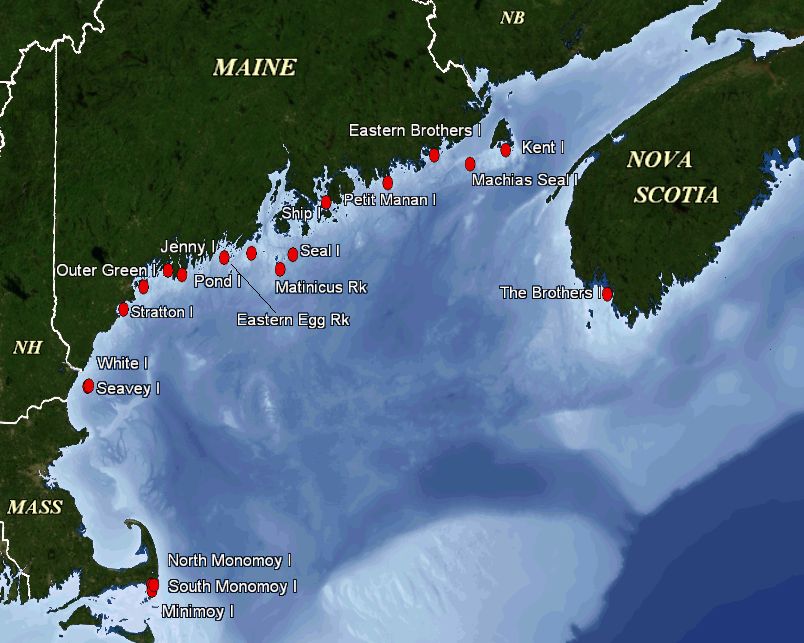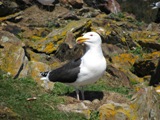Seabird Conservation in the Gulf of Maine
The Gulf of Maine ecosystem is one of the most productive ecosystems in the world, supporting a rich diversity of invertebrates, fish, marine birds and mammals. The area is home to many breeding colonies of seabirds, including federal and state listed species. The Gulf of Maine Seabird Working Group primarily works with the following marine birds:
 |
| The Gulf of Maine |
- Laughing Gull (Larus atricilla)
- Herring Gull (Larus argentatus)
- Great Black-backed Gull (Larus marinus)
- Common Tern (Sterna hirundo)
- Arctic Tern (Sterna paradisaea), Maine state threatened
- Roseate Tern (Sterna dougallii), federally endangered
- Least Tern (Sterna antillarum), Maine state endangered
- Common Murre (Uria aalge)
- Razorbill (Alca torda), Maine state threatened
- Black Guillemot (Cepphus grylle)
- Atlantic Puffin (Fratercula arctica), Maine state threatened
- Leach's Storm-Petrel (Oceanodroma microsoma)
- Double-crested Cormorant (Phalacrocorax auritus)
- Great Cormorant (Phalacrocorax carbo)
- Common Eider (Somateria mollissima)
- Great Shearwater (Ardenna gravis), non-breeding
- Manx Shearwater (Puffinus puffinus)
Terns and alcids (e.g. Atlantic Puffins and Razorbills) have responded favorably to restoration and on-going management efforts. Seabird restoration can be a slow process, requiring several years before birds are attracted to a site and success of the colony once established may be jeopardized by poor food availability or predators. Although restoration has been successful at several sites, the Gulf of Maine Seabird Working Group (GOMSWG) is concerned about the limited distribution of terns and alcids (12 or fewer sites) and that many species populations are below the 2006 objectives set by the Maine Department of Inland Fish and Wildlife (MDIFW). Increasing the geographic distribution and the number of managed colonies will minimize the potential for a single catastrophic event (i.e. oil spill or disease) from devastating a significant percentage of the population. The most significant tern and alcid colonies currently require annual management to protect the colonies from predators. For the most part, islands supporting gulls, eiders, and black guillemots are not intensively managed and breeding population sizes are infrequently surveyed. The largest gull and cormorant census for the Gulf of Maine was completed in 2008 using a combination of ground and aerial photo counts.
All seabird data for the state of Maine is stored in a database maintained by the Maine Department of Inland Fisheries and Wildlife, Wildlife Division in Bangor, Maine. A Maine Seabird Atlas was produced in 2012 by the MDIFW Wildlife Division in Bangor, Maine Coastal Islands National Wildlife Refuge, USFWS Maine Coastal Program in Falmouth, and the Maine Natural History Observatory in Gouldsboro. Contact Glen Mittelhauser at Maine Natural History Observatory for more information about the seabird atlas. Another interesting collaborative effort in the Gulf of Maine Integreated Ecological Research Program, GOMIERP (www.gomierp.org). GOMSWG participants are currently studying the foraging behavior of seabirds, and the proposed GOMIERP project would like to link researchers from many disciplines to better understand the Gulf of Maine ecosystem.
Critical Nesting Islands
- The Gulf of Maine is the southern limit of the range of the Arctic Tern, Atlantic Puffin and Razorbill.
- Arctic Terns nest on only 8 islands and 3 islands support 90% of the breeding population.
- The largest Atlantic Puffin colony in the Gulf of Maine is at Machias Seal Island with over 6,500 breeding pairs.
- Razorbills currently nest on six islands in the Gulf of Maine, with a majority of the population nesting on Machias Seal Island and Matinicus Rock.
- The Gulf of Maine is the northern most limit of the federally endangered Roseate Tern breeding range. Roseate Terns nests at only 8 locations in the Gulf of Maine and populations have declined in recent years.
 |
| Actively Managed Seabird Restoration Islands in the Gulf of Maine (map by USFWS) |
2024 Breeding Pair Counts from Managed Gulf of Maine Seabird Colonies
Notes: Managed colonies refers to islands where seasonal researchers are present and annual surveys are conducted. Although small numbers of seabirds nest on unmanaged sites (most of which are protected), data from these colonies is not presented here. Data was provided by Gulf of Maine Seabird Working Group participants. Values notated with "*" are from 2019, "**" from 2021.
| Island | Common Tern | Arctic Tern | Roseate Tern | Atl. Puffin | Razorbill | Common Murre | Laughing Gull |
|---|---|---|---|---|---|---|---|
| Machias Seal (NB) | 0 | 318 | 0 | 8,635* | 3,715* | 539 | 0 |
| The Brothers (NS) | 595 | 61 | 63 | 0 | 0 | 0 | 0 |
| Petit Manan (ME) | 722 | 318 | 0 | 60 | 6 | 0 | 6 |
| Ship (ME) | 1,387 | 0 | 0 | 0 | 0 | 0 | 0 |
| Seal (ME) | 765 | 480 | 0 | 672 | 101 | 0 | 0 |
| Matinicus Rock (ME) | 380 | 726 | 0 | 355+* | 347** | 18 | 7 |
| Metinic (ME) | 868 | 358 | 0 | 0 | 0 | 0 | 0 |
| Pond (ME) | 1,763 | 24 | 129 | 0 | 0 | 0 | 0 |
| Eastern Egg Rock (ME) | 1,298 | 48 | 79 | 87+ | 0 | 0 | 2,457 |
| Western Egg Rock (ME) | 0 | 0 | 0 | 0 | 0 | 0 | 0 |
| Jenny (ME) | 1,726 | 0 | 22 | 0 | 0 | 0 | 0 |
| Outer Green (ME) | 1,883 | 0 | 0 | 0 | 0 | 0 | 0 |
| Stratton (ME) | 1,172 | 5 | 94 | 0 | 0 | 0 | 0 |
| White & Seavey (NH) | 3,069 | 0 | 133 | 0 | 0 | 0 | 0 |
| Monomoy (MA) | 17,122 | 0 | 19 | 0 | 0 | 0 | 7,365 |
| 2024 TOTAL | 32,750 | 2,316 | 422 | 9,801+ | 4,169+ | 557 | 9,835 |
Restoration Efforts
The first task in re-establishing a colony is to make the island safe for nesting. Islands are closed to the public seasonally to limit disturbance (see Island Closures below). Many seabirds, especially terns, typically do not prefer to nest on islands where Herring and Great Black-backed Gulls also nest. When gulls are present at restoration sites, biologists acquire special federal and state permits to prevent gulls from nesting, discourage their presence, or lethally remove them. From 1986 to 1988, the USFWS implemented a rigorous gull control program on Seal and Petit Manan Islands which effectively reduced the number of nesting gulls and created habitat conditions essential for terns. Collectively, these two islands now support 44% of Maine's breeding tern population and 51% of the Atlantic Puffin population.
Social attraction has regularly been used in the Gulf of Maine to attract seabirds (alcids and terns) to restoration sites although gull removal may be the most important factor to successfully attracting birds to a site. The National Audubon Society pioneered the use of social attraction techniques to establish new tern and puffin colonies, which includes deploying decoys in suitable nesting habitat and broadcasting the sounds of an active colony. In addition to social attraction, Audubon also transplanted Atlantic Puffin chicks from Great Island in Newfoundland and raised them on Maine islands (Eastern Egg Rock and Seal Island) in the 1970's and 1980's. These chicks eventually returned to Maine islands to breed. The Gulf of Maine currently has five active puffin colonies (Petit Manan National Wildlife Refuge, Seal Island National Wildlife Refuge, Matinicus Rock, Eastern Egg Rock, and Machias-Seal Island).
Predator management is also critical to restoring seabirds on new islands and continued predator management has been necessary to maintain an active colony at an established site. The presence of a single mammalian predator (e.g. mink) or avian predator (e.g. great-horned owl, black-crowned night heron, or gull species) on a seabird colony can have disastrous effects on nesting birds. In addition to monitoring the health and success of colonies, seabird technicians also monitor impact of predators and control them when necessary.
Maine's Nationally Significant Seabird Nesting Islands
In the mid-1990's, biologists from the US Fish and Wildlife Service (USFWS), Maine Department of Inland Fish and Wildlife (MDIFW), The Nature Conservancy (TNC), and Maine Coast Heritage Trust (MCHT) compiled a list of 677 islands where seabirds were historically or currently present and developed criteria for Nationally Significant Seabird Islands. Approximately half of the 377 Nationally Significant Seabird Islands identified lack permanent protection and are at risk of being developed for residential or commercial purposes. Partners in Maine continue to work cooperatively to protect all Significant Islands. All islands are threatened by the introduction of trash or non-native invasive plants and animals. The list of Significant Islands can be viewed at: http://www.fws.gov/GOMCP/pdfs/nesting_islands_data.pdf. The designation criteria can be found in Maine Coastal Islands National Wildlife Refuge Land Protection Plan, Appendix A of the 2005 Comprehensive Conservation Plan.
Island Closures and the Universal Seabird Sign
A significant limiting factor to seabird nesting success is human disturbance. In 2006, seabird managers developed a Universal Seabird Sign, to allow the public to identify when an island is closed from the water. Seabirds, wading birds, waterfowl, and bald eagle nesting pairs require undisturbed environments during the nesting season.
Access is not permitted from:- April 1 to August 31 on tern, alcid, and petrel islands
- and from April 1 to July 31 for islands with nesting gulls, cormorants, and/or eiders.
These 2'x3' metal signs are available to any island landowner who would like to help protect nesting species. Canada began using the Universal Seabird Sign at significant islands in 2008. Smaller, plastic versions of the sign are available for posting at boat ramps or popular access points for kayakers. To acquire a Universal Seabird Sign for your island or boat ramp, contact Maine Coastal Islands NWR at (207) 546-2124.
 |
| Universal Seabird Sign at Eastern Brothers Islands, Jonesport, Maine (photo by USFWS) |
Gallery

Laughing Gull, USFWS
Herring Gull, USFWS
Great Black-backed Gull, Anna MacDonald
Common Tern, by Kirk Rogers
Arctic Tern, by Kirk Rogers
Roseate Tern, by Kirk Rogers
Common Murre, Emily Pipher
Razorbill, Brian Guzzetti
Black Guillemot, Kirk Rogers
Atlantic Puffin, USFWS
Leach's Storm-petrel, C. Schlawe
Female Common Eider, CLO
Male Common Eider, Brian Guzzetti
Great Shearwater, Amanda Boyd